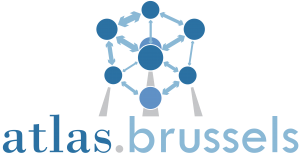You are entering the beta version of atlas.brussels
atlas.brussels is still under development. During the beta phase, the website and the visualization tool are subject to change frequently. Your feedback (through the contact tab) is more than welcome to help identify and fix bugs and to improve the contents.

Why atlas.brussels?
atlas.brussels is a new tool among many others to explore the geographical properties of Brussels and its surroundings. The originality of this tool is to focus on interactions and exchanges between pairs of places much more than the socio-economic characteristics of these places. Therefore, the majority of the information included into atlas.brussels is based on relational data that can be represented through the shape of interaction networks. This allows to reveal places characterized by high interaction with other ones (interrelationships taken into account being as diverse as mobility, information and communications), whatever their socio-economic commonalities or differences.

An atlas based on interactions
A clear and understandable visualization of interaction networks is challenging. Therefore, atlas.brussels mostly relies on a quite recent approach. Networks connecting places are represented through chorochromatic maps showing communities, which are subsets of places strongly interrelated and more precisely more related between them than with other places out of the community.
These communities result from the application of an algorithm called the Louvain Method, one of the community detection algorithms minimizing the most the time of computation. This reveals different and nested geographies of Brussels and its surroundings.
These communities result from the application of an algorithm called the Louvain Method, one of the community detection algorithms minimizing the most the time of computation. This reveals different and nested geographies of Brussels and its surroundings.

Contents
This website is mainly constituted by a visualization tool (available in the section “Explore the atlas”) putting together results published in various scientific journals but not always easily accessible for everyone, with some supplementary options such as changing the limits of the studied area and hence going from intra-urban Brussels to a nationwide map.
Other sections detail the main sources of data as well as the methodologies that have been used, a list of the publications related to the Bru-Net project and offer some Focuses on specific elements we would like to highlight.
Other sections detail the main sources of data as well as the methodologies that have been used, a list of the publications related to the Bru-Net project and offer some Focuses on specific elements we would like to highlight.

A dimension of the Bru-Net project
atlas.brussels results from the Bru-Net project (“Brussels Networks”), a scientific and multidisciplinary research project funded by Brussels-Capital Region – Innoviris (Anticipate programme) and hosted by the Université catholique de Louvain. It aims to observe interactions into the city of Brussels and its surroundings compared to Belgium, to better understand the Belgian capital city, but also to develop new methods for modelling and visualizing big spatial datasets. The diversity of the results reveal the spatial complexities in and around Brussels.
atlas.brussels has been realized by Olivier Finance
The website and the interactive visualization have been built by Olivier Finance, post-doc at UCLouvain into the Bru-Net project (co-promotors: Isabelle Thomas and Jean-Charles Delvenne). The atlas benefited from contributions from other members of the project and more particularly from the work of Arnaud Adam who performed most of the analyses. More information about the team members in section “The team”.

 Explore the atlas
Explore the atlas